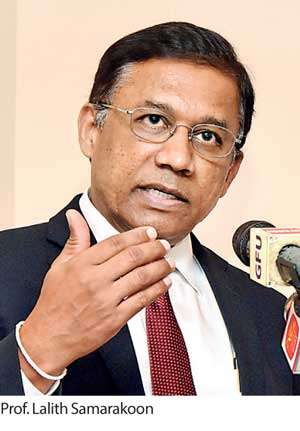03 Dec 2018 - {{hitsCtrl.values.hits}}
 By Nishel Fernando
By Nishel Fernando
The National Economic Council (NEC) asserted that a medium to long-term economic policy and programme enhancing economic growth is the best and only viable remedy to address the fundamental issues in Sri Lanka’s economy amid a challenging global environment, which is expected to lead to slower growth and higher borrowing cost for emerging and frontier markets.
“We need to have an economic policy and programmes, which are growth-oriented, investment-oriented and export-oriented, that provides proper incentives in order achieve the anticipated growth.
“Ultimately, growth is the best and only answer. Sri Lanka will have to grow much higher than 4-5 percent we have seen during last few years,” National Economic Council (NEC) Secretary General and Chief Economist Prof. Lalith Samarakoon, said.
He made these remarks during a discussion on “Sri Lanka’s Economic Challenges in the year 2019’ in Colombo last Friday.
Prof. Samarakoon noted that it would be challenging for Sri Lanka to reach the targeted 4 percent GDP growth this year while achieving respective targets in fiscal and current account deficits.
He pointed out that normalisation of monetary policies in advanced economics, particularly in the United Stated, has led to higher cost of borrowing for developing countries and movement of capital back to advanced economics.
He outlined a list of global woes which are adversely impacting Sri Lanka and other emerging and frontier economies ranging from slowing down of global economic growth to Brexit to volatility in internationally capital markets to the trade war between the United States and China.
Speaking of debt servicing from next year amid the current political crisis in the country, Prof. Samarakoon assured that Sri Lanka has the ability and provisions to pay off all its contractual debt on time regardless of the political situation.
However, he admitted that Sri Lanka will have to pay a higher risk premium for future borrowings, given the prevailing political uncertainty in the country.
He noted that Sri Lanka’s bonds in the secondary markets are already trading at a 5.5 percent premium rate to the United States 10-year treasury yields.
Moody’s recently downgraded Sri Lanka’s ratings to B2 from B1 and changed the outlook to Stable from Negative for the first time since it began rating the Sri Lankan sovereign in 2010.
The rating agency said the protracted political crisis exacerbates the tightening in external domestic financing and reserve position of Sri Lanka, having a lasting impact on policy.
According to Prof. Samarakoon, Sri Lanka has debt repayments of US $5 billion on average for the next five-year period.
Further, he outlined that a new crisis could be triggered in Italy as European Union (EU) and Italy are yet to reach a deal over managing Italy’s debt and budget deficit.
He said that such a crisis could pave way for a Greece-like scenario, resulting in higher bond yields in the rest of the world, further increasing the cost of financing for economies such as Sri Lanka.
However, he said that the oil (Brent) prices have come down by nearly 31 percent since last October which is a 12 percent decline compared to the previous year.
Speaking of deprecation of the rupee against US dollar, Prof. Samarakoon admitted that the local currency has depreciated 15 percent so far this year while the depreciation of the rupee has accelerated in the past few months compared to the currencies of regional peers.
“Rupee depreciation reflects the structural weakness of the economy,” he stressed.
Prof. Samarakoon said the twin deficit—the budget deficit and the current account deficit—is the main reason for the depreciation of the currency, as the countries with twin deficits have seen depreciation of their currencies faster than others.
He noted that normalisation of interest rates in the US which resulted in better yields, has also caused the outflow of foreign funds from Sri Lanka’s capital and debt markets.
Sri Lanka has seen over Rs.17 billion of outflows from stocks and over Rs.118 billion from government securities so far this year.
16 Nov 2024 39 minute ago
16 Nov 2024 3 hours ago
16 Nov 2024 5 hours ago
16 Nov 2024 5 hours ago
16 Nov 2024 7 hours ago